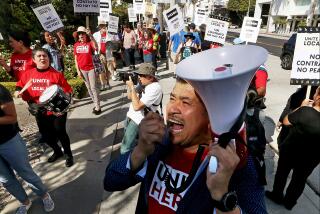Study Cites $1.3 Billion in Airport Benefits
- Share via
Burbank Airport is the source of 38,000 jobs and $1.3 billion annually in economic benefits, mostly to the San Fernando Valley and adjoining areas, according to a survey made public by the airport Thursday.
The study was conducted for the Burbank-Glendale-Pasadena Airport Authority, which presented the results at a breakfast meeting at the Burbank Airport Hilton. Airport officials have been fighting a long-running battle with area homeowners, who protest jetliner noise and want to see flights from the airport limited.
“The airport must be recognized for the prosperity it brings,” said Airport Authority President Robert Garcin in introducing the report. “Thousands of people are counting on it now and into the future.”
The report calculated both direct and indirect benefits. Direct benefits include such factors as the payroll of employees of the airport and its tenants, and money spent by airline passengers in the area.
Indirect benefits include jobs created by the subsequent spending and re-spending of money that was originally drawn to the region by the presence of the airport, including the personal spending of airport employees and money spent by companies that profit from airport business.
The airport and related industries are directly responsible for 13,000 jobs and $813 million annually--$467 million in salaries, $106 million in purchases and $240 million in local spending by air travelers, the survey concluded.
Indirect benefits amount to $519 million and 25,400 jobs, said the study, done by the URS Corp. of Santa Barbara.
Los Angeles County receives 80% of the economic benefits and 92% of the jobs, the survey said.
Almost half the jobs, with earnings of $414.5 million, are held by residents of Burbank or the Valley, according to the report. Half of those benefits go to a zone made up of Burbank, North Hollywood, Van Nuys, Sherman Oaks and Encino, it said.
A similar study of 1982, credited the airport with generating 22,000 jobs and $550 million in payrolls.
Airport spokesmen said the figures had increased because the previous survey did not take into account the spending of travelers. In addition, a more prosperous economy this year has caused an increase in air travel and more flights by new air carriers, he said.
In 1982 the airport handled 28,000 flights, contrasted with an expected 50,000 in 1986, airport spokesman Victor Gill said.
The report included a survey of passengers at the airport, which found that 44.3% were residents of the San Fernando Valley, 22% were from the San Gabriel Valley and 7.4% from other areas of Los Angeles.
More than 48% said they used the airport less than once a month, but almost 10% said they used it once a week or more.
When asked what changes they wanted, almost 17% requested a newer terminal. The present Burbank terminal, 55 years old, is scheduled to be replaced in the 1990s.
More than 13% asked for more flights and 11% requested more parking space.
Questioned on Drawbacks
Richard Close, president of the Sherman Oaks Homeowners Assn. and spokesman for an airport anti-noise coalition of six Valley area homeowners groups, asked the researchers presenting the report whether they had calculated decreases in the value of property in the area, noise pollution and neighborhood “decay.”
“Or did you just measure the pluses, and not the minuses?” Close asked.
Researchers said they did not look for economically harmful effects from the airport’s presence. Airport manager T. E. Greer responded that previous studies had found “no measureable difference whatsoever in property values around the airport” compared to property value changes elsewhere in Burbank and the San Fernando Valley.
As the breakfast ended, Close complained to an airport official that the survey was akin to “demonstrating the economic benefits of cancer because it provides jobs for doctors and hospital workers.”
More to Read
Sign up for Essential California
The most important California stories and recommendations in your inbox every morning.
You may occasionally receive promotional content from the Los Angeles Times.













